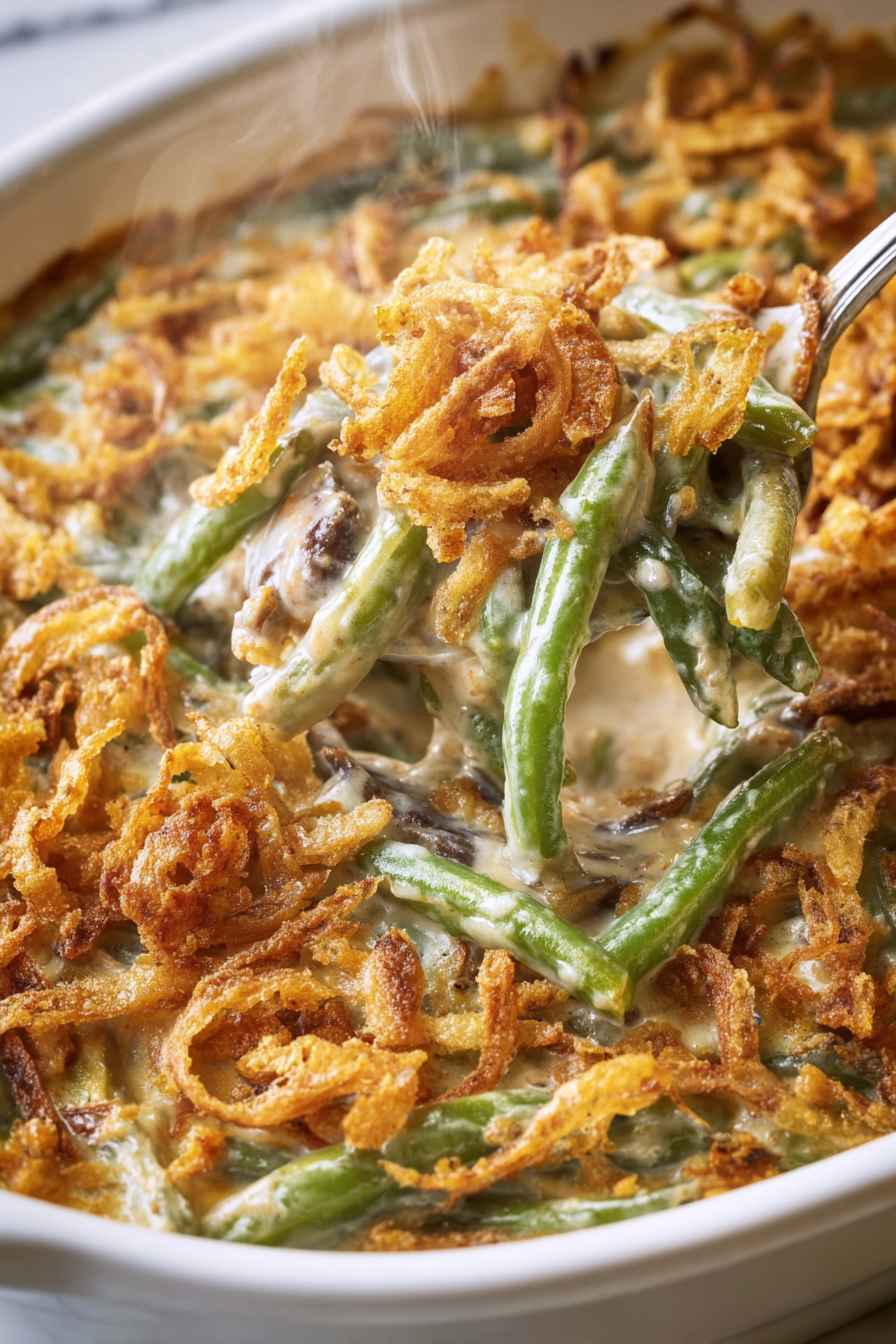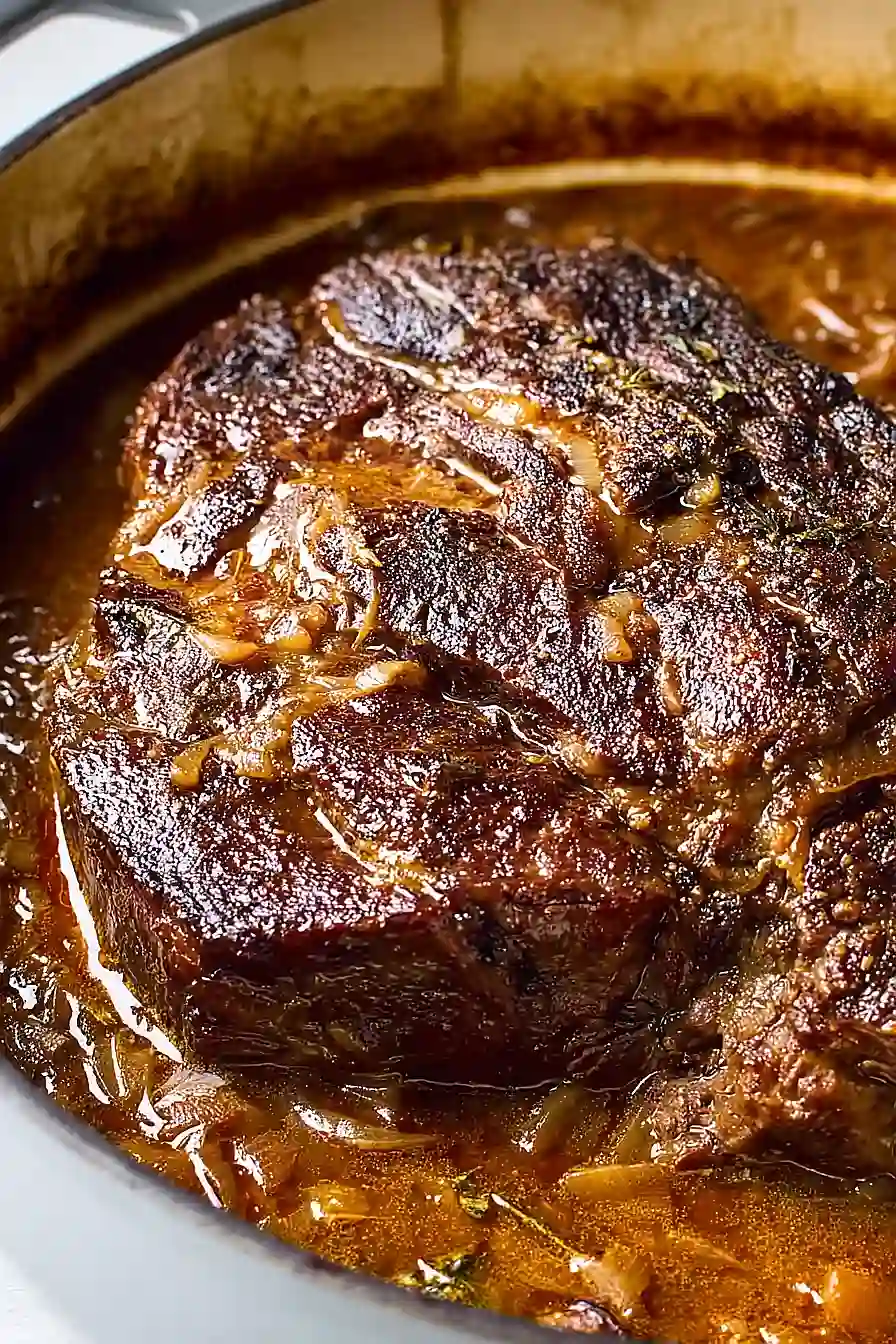Here is my favorite crockpot beef tenderloin recipe, with bacon-wrapped beef, fresh rosemary, and a rich balsamic sauce that cooks low and slow while you go about your day.
This beef tenderloin is my go-to recipe when I want something special but don’t want to spend hours in the kitchen. I love that the crockpot does all the work, and the bacon keeps everything moist and flavorful. Perfect for a Sunday dinner without all the fuss!
Why You’ll Love This Beef Tenderloin
- Restaurant-quality at home – This crockpot method gives you melt-in-your-mouth tender beef that rivals any steakhouse, without the hefty price tag or need for fancy cooking skills.
- Hands-off cooking – Your slow cooker does all the heavy lifting while you prep side dishes or relax, making it perfect for holiday dinners or special occasions when you want to spend less time in the kitchen.
- Bacon-wrapped goodness – The thick pepper bacon adds incredible flavor and keeps the tenderloin juicy as it cooks low and slow.
- Impressive presentation – This looks like you spent hours slaving away, but it’s actually one of the easiest ways to cook beef tenderloin. Your guests will be amazed when you tell them it came from a crockpot.
What Kind of Beef Tenderloin Should I Use?
For this crockpot recipe, you’ll want to grab a 3-4 pound piece from the thick end of a whole tenderloin, which is sometimes called the butt end or head. This cut is more affordable than the center-cut and works perfectly in a slow cooker since the low and slow cooking method helps keep it tender. If your butcher has already trimmed it for you, that’s great, but if not, just trim off any excess silver skin or fat before cooking. You can also ask your butcher to cut a specific size for you if you don’t see exactly what you need in the case – most are happy to help you get the right portion for your recipe.
Options for Substitutions
This recipe has some room for flexibility, though a few ingredients are pretty important to keep:
- Beef tenderloin: This is one ingredient you really don’t want to substitute. Tenderloin is what makes this dish special – it’s tender and cooks beautifully in the crockpot. Other cuts like sirloin or ribeye won’t give you the same melt-in-your-mouth result.
- Thick pepper bacon: Regular bacon works fine if you can’t find thick-cut. You can also use pancetta for a slightly different flavor, though you might want to add a pinch of black pepper since it’s not as peppery.
- Fresh rosemary: If you only have dried rosemary, use about 1 tablespoon instead of the fresh sprigs. Just remember that dried herbs are more concentrated than fresh.
- Balsamic vinegar: Red wine vinegar mixed with a teaspoon of honey can work in a pinch, though the flavor will be slightly different and less sweet.
- Dijon mustard: Yellow mustard or whole grain mustard can step in here. If using yellow mustard, you might want to add just a touch less since it can be sharper.
- Beef stock: Chicken stock or even red wine can substitute here, though beef stock really does give the best flavor for this particular dish.
Watch Out for These Mistakes While Cooking
The biggest mistake when making crockpot beef tenderloin is cooking it too long, which turns this expensive cut dry and tough – since tenderloin is already tender, it only needs 2-3 hours on low, and you should use a meat thermometer to pull it at 130-135°F for medium-rare.
Skipping the step of searing or crisping the bacon beforehand means you’ll end up with rubbery, pale bacon instead of the crispy, flavorful coating you want, so take a few extra minutes to brown it in a skillet first.
Another common error is placing the tenderloin directly on the bottom of the crockpot where it can overcook – instead, create a bed with the onions and rosemary to lift the meat slightly and add more flavor.
Finally, don’t forget to let the tenderloin rest for 10 minutes after cooking before slicing, which allows the juices to redistribute and keeps every slice moist.
What to Serve With Beef Tenderloin?
Since this beef tenderloin has such rich flavors from the bacon and balsamic, I love pairing it with creamy mashed potatoes or garlic roasted potatoes to soak up all that delicious sauce. A side of roasted vegetables like green beans, Brussels sprouts, or carrots adds a nice balance to the meal without competing with the meat. If you want to keep things simple, a crisp Caesar salad or arugula salad with shaved parmesan works perfectly as a lighter option. For a fancier dinner, try serving it with creamy polenta or buttered egg noodles, which both pair beautifully with the balsamic sauce.
Storage Instructions
Store: Keep your leftover beef tenderloin in an airtight container in the fridge for up to 3 days. I like to store the meat and sauce separately so the beef doesn’t get too soft. It makes great sandwiches the next day, or you can slice it thin for a quick salad topper.
Freeze: You can freeze the cooked tenderloin for up to 2 months, though the texture won’t be quite as tender as fresh. Wrap it tightly in plastic wrap, then foil, and store the sauce in a separate freezer-safe container.
Reheat: Gently warm the beef in the oven at 250°F until just heated through, about 15-20 minutes depending on thickness. You don’t want to overcook it or it’ll dry out. Heat the sauce separately on the stovetop and drizzle it over the warmed meat right before serving.
| Preparation Time | 15-20 minutes |
| Cooking Time | 240 minutes |
| Total Time | 255-260 minutes |
| Level of Difficulty | Medium |
Estimated Nutrition
Estimated nutrition for the whole recipe (without optional ingredients):
- Calories: 2600-3300
- Protein: 320-400 g
- Fat: 140-190 g
- Carbohydrates: 55-70 g
Ingredients
For the beef tenderloin:
- black pepper to taste (freshly ground preferred)
- 3/4 cup beef stock (I use Kettle & Fire)
- 12 strips thick bacon (for wrapping)
- 3.5 lb beef tenderloin (room temperature, about 70°F)
- salt to taste
- 1 small onion (sliced into 1/4-inch rings)
- 3 sprigs fresh rosemary (for aromatic flavor)
For the glaze:
- 1 tbsp flour (for thickening)
- 1 tbsp Dijon mustard (I prefer Grey Poupon)
- 2 tbsp sugar
- 1/3 cup balsamic vinegar
- 4 garlic cloves (minced fine, about 1 tbsp)
Step 1: Prepare the Beef and Create the Bacon Wrap
- 3.5 lb beef tenderloin
- salt to taste
- black pepper to taste
- 12 strips thick bacon
Remove the beef tenderloin from the refrigerator and let it sit at room temperature for about 30 minutes to ensure even cooking throughout.
While it comes to temperature, pat the beef dry with paper towels—this helps the seasoning stick better.
Season the entire surface generously with salt and freshly ground black pepper.
Lay the thick bacon strips slightly overlapping on a clean work surface, then carefully place the beef tenderloin across them and roll the bacon around the beef, tucking the ends underneath to create a secure wrap.
This bacon layer will add flavor and help keep the meat moist during the long, slow cooking process.
Step 2: Build the Aromatic Base and Start Slow Cooking
- bacon-wrapped beef from Step 1
- 1 small onion
- 3 sprigs fresh rosemary
- 3/4 cup beef stock
Place the bacon-wrapped beef tenderloin seam-side down in your crockpot.
Arrange the sliced onion rings and fresh rosemary sprigs around the beef—these will infuse the cooking liquid with subtle flavor.
Pour the beef stock carefully around (not over) the beef to avoid washing away the seasoning.
Cover the crockpot and cook on low heat for 4 hours.
The beef will cook gently and evenly at this temperature, and the bacon will render its fat into the liquid, creating a rich base for the glaze.
I prefer this gentle approach because it keeps the tenderloin incredibly tender and juicy rather than risking overcooking with high heat.
Step 3: Rest the Beef and Prepare the Glaze Base
- cooked beef from Step 2
- cooking liquid from Step 2
Carefully remove the beef tenderloin from the crockpot and place it on a cutting board.
Let it rest for 10 minutes—this allows the juices to redistribute throughout the meat, ensuring every slice stays moist and tender.
While the beef rests, strain the cooking liquid from the crockpot into a small saucepan, discarding the onion and rosemary.
You should have roughly 3/4 cup of flavorful liquid; if you have significantly more, simmer it briefly to concentrate the flavors.
Set the saucepan over medium heat and keep it warm while you prepare the remaining glaze components.
Step 4: Create and Thicken the Balsamic Glaze
- cooking liquid from Step 3
- 1 tbsp flour
- 1 tbsp Dijon mustard
- 1/3 cup balsamic vinegar
- 4 garlic cloves
- 2 tbsp sugar
In a small bowl, whisk together the flour and Dijon mustard to form a smooth paste—this prevents lumps from forming when you add it to the hot liquid.
Whisk this mixture directly into the warm beef stock in the saucepan, stirring constantly to break up any clumps.
Add the balsamic vinegar, minced garlic, and sugar, stirring well to combine.
Simmer over medium heat for 3-4 minutes, stirring occasionally, until the glaze thickens enough to coat the back of a spoon.
I like to let the garlic cook for a full minute before it reaches final thickness so it loses its raw edge and melds into the glaze rather than tasting sharp.
Step 5: Slice and Plate with Glaze
- rested beef from Step 3
- balsamic glaze from Step 4
Slice the rested beef tenderloin into 1/2-inch to 3/4-inch thick slices, cutting perpendicular to the muscle fibers for maximum tenderness.
Arrange the slices on a serving platter or individual plates.
Pour the warm balsamic glaze generously over the sliced beef, allowing it to pool slightly around each slice.
The glaze will cling beautifully to the meat and create an elegant presentation while adding a sweet-savory depth that complements the rich beef and bacon perfectly.







